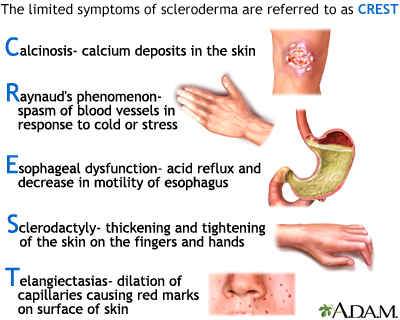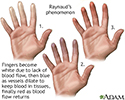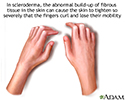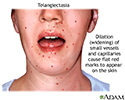Scleroderma
Progressive systemic sclerosis; Systemic sclerosis; Limited scleroderma; CREST syndrome; Localized scleroderma; Morphea - linear; Raynaud's phenomenon - sclerodermaScleroderma is a disease that involves the buildup of fibrous tissue in the skin and elsewhere in the body. It also damages the cells that line the walls of small arteries. This leads to tissue injury due to poor blood supply.
Causes
Scleroderma is a type of autoimmune disorder. In this condition, the immune system mistakenly attacks and damages healthy body tissue.
Autoimmune disorder
An autoimmune disorder occurs when the body's immune system attacks and destroys healthy body tissue by mistake. There are more than 80 autoimmune d...

The cause of scleroderma is unknown. A buildup of a protein normally found in the body (called collagen) in the skin and other organs leads to the symptoms of the disease.
The disease most often affects people ages 30 to 50 years. Women get scleroderma more often than men. Some people with scleroderma have a history of being around silica dust and polyvinyl chloride, but most do not.
Widespread scleroderma can occur with other autoimmune diseases, including systemic lupus erythematosus and polymyositis. These cases are referred to as undifferentiated connective tissue disease or overlap syndrome.
Systemic lupus erythematosus
Systemic lupus erythematosus (SLE) is an autoimmune disease. In this disease, the immune system of the body mistakenly attacks healthy tissue. It c...

Polymyositis
Polymyositis and dermatomyositis are rare inflammatory diseases. (The condition is called dermatomyositis when it involves the skin. ) These disease...

Symptoms
Some types of scleroderma affect only the skin, while others affect the whole body.
- Localized scleroderma (also called morphea) -- Often affects only the skin on the chest, abdomen, or limb but not usually on the hands and face. Morphea develops slowly, and rarely spreads in the body or causes serious problems such as internal organ damage.
- Systemic scleroderma, or sclerosis -- May affect large areas of skin and organs such as the heart, lungs, or kidneys. There are two main types, limited disease (CREST syndrome) and diffuse disease.
Skin signs of scleroderma may include:
- Fingers or toes that turn blue or white in response to cold temperatures (Raynaud phenomenon)
Raynaud phenomenon
Raynaud phenomenon is a condition in which cold temperatures or strong emotions cause blood vessel spasms. This blocks blood flow to the affected re...
 ImageRead Article Now Book Mark Article
ImageRead Article Now Book Mark Article - Stiffness and tightness of skin of fingers, hands, forearm, and face
- Hair loss
- Skin that is darker or lighter than normal
- Small white lumps of calcium beneath the skin that sometimes ooze a white substance that looks like toothpaste
- Sores (ulcers) on the fingertips or toes
- Tight and mask-like skin on the face
- Telangiectasias, which are small, widened blood vessels visible beneath the surface on the face or at the base of fingernails
Bone and muscle symptoms may include:
- Joint pain, stiffness, and swelling, resulting in loss of motion. The hands are often involved due to fibrosis around tissue and tendons.
- Numbness and pain in the feet.
Breathing problems may result from scarring in the lungs and can include:
- Dry cough
Cough
Coughing is an important way to keep your throat and airways clear. But too much coughing may mean you have a disease or disorder. Some coughs are d...
 ImageRead Article Now Book Mark Article
ImageRead Article Now Book Mark Article - Shortness of breath
- Wheezing
Wheezing
Wheezing is a high-pitched whistling sound during breathing. It occurs when air moves through narrowed breathing tubes in the lungs.
 ImageRead Article Now Book Mark Article
ImageRead Article Now Book Mark Article - Increased risk for lung cancer
Lung cancer
Lung cancer is cancer that starts in the lungs. The lungs are located in the chest. When you breathe, air goes through your nose, down your windpipe...
 ImageRead Article Now Book Mark Article
ImageRead Article Now Book Mark Article
Digestive tract problems may include:
- Difficulty swallowing
Difficulty swallowing
Difficulty with swallowing is the feeling that food or liquid is stuck in the throat or at any point before the food enters the stomach. This proble...
 ImageRead Article Now Book Mark Article
ImageRead Article Now Book Mark Article - Esophageal reflux or heartburn
Esophageal reflux
Gastroesophageal reflux disease (GERD) is a condition in which the stomach contents leak backward from the stomach into the esophagus (food pipe). F...
 ImageRead Article Now Book Mark Article
ImageRead Article Now Book Mark ArticleHeartburn
Heartburn is a painful burning feeling just below or behind the breastbone. Most of the time, it comes from the esophagus. The pain often rises in ...
 ImageRead Article Now Book Mark Article
ImageRead Article Now Book Mark Article - Bloating after meals
Bloating
Abdominal bloating is a condition in which the belly (abdomen) feels full and tight. Your belly may look swollen (distended).
 ImageRead Article Now Book Mark Article
ImageRead Article Now Book Mark Article - Constipation
- Diarrhea
- Problems controlling stools
Heart problems may include:
- Abnormal heart rhythm
- Fluid around the heart
- Fibrosis in heart muscle, decreasing heart function
Kidney and genitourinary problems may include:
- Development of kidney failure
- Erectile dysfunction in men
- Vaginal dryness in women
Vaginal dryness
Vaginal dryness is present when the tissues of the vagina are not well-lubricated and healthy.
 ImageRead Article Now Book Mark Article
ImageRead Article Now Book Mark Article
Exams and Tests
The health care provider will do a complete physical exam. The exam may show:
- Tight, thick skin on the fingers, the face or elsewhere.
- The skin at the base of the fingernails may be looked at with a lighted magnifying glass for abnormalities of the small blood vessels.
- The lungs, heart and abdomen will be examined for abnormalities.
Your blood pressure will be checked. Scleroderma can cause small blood vessels in the kidneys to become narrowed. Problems with your kidneys can lead to high blood pressure and decrease function of the kidney.
Blood pressure
Blood pressure is a measurement of the force on the walls of your arteries as your heart pumps blood through your body. You can measure your blood pr...

High blood pressure
Blood pressure is a measurement of the force exerted against the walls of your arteries as your heart pumps blood to your body. Hypertension is the ...

Blood and urine tests may include:
- Antinuclear antibody (ANA) panel
Antinuclear antibody
The antinuclear antibody panel is a blood test that looks at antinuclear antibodies (ANA). ANA are antibodies produced by the immune system that bind...
 ImageRead Article Now Book Mark Article
ImageRead Article Now Book Mark Article - Scleroderma antibody testing
- ESR (sed rate)
ESR
ESR stands for erythrocyte sedimentation rate. It is commonly called a "sed rate. "It is a test that indirectly measures the level of certain protei...
 ImageRead Article Now Book Mark Article
ImageRead Article Now Book Mark Article - Rheumatoid factor
Rheumatoid factor
Rheumatoid factor (RF) is a blood test that measures the amount of the RF antibody in the blood.
 ImageRead Article Now Book Mark Article
ImageRead Article Now Book Mark Article - Complete blood count
Complete blood count
A complete blood count (CBC) test measures the following:The number of white blood cells (WBC count)The number of red blood cells (RBC count)The numb...
 ImageRead Article Now Book Mark Article
ImageRead Article Now Book Mark Article - Metabolic panel, including creatinine
Metabolic panel
The basic metabolic panel is a group of blood tests that provides information about your body's metabolism.
 ImageRead Article Now Book Mark Article
ImageRead Article Now Book Mark Article - Heart muscle tests
- Urinalysis
Urinalysis
Urinalysis is the physical, chemical, and microscopic examination of urine. It involves a number of tests to detect and measure various compounds th...
 ImageRead Article Now Book Mark Article
ImageRead Article Now Book Mark Article
Other tests may include:
- Chest x-ray
Chest x-ray
A chest x-ray is an x-ray of the chest, lungs, heart, large arteries, ribs, and diaphragm.
 ImageRead Article Now Book Mark Article
ImageRead Article Now Book Mark Article - CT scan of the lungs
CT scan of the lungs
A chest CT (computed tomography) scan is an imaging method that uses x-rays to create cross-sectional pictures of the chest and upper abdomen....
 ImageRead Article Now Book Mark Article
ImageRead Article Now Book Mark Article - Electrocardiogram (ECG)
Electrocardiogram (ECG)
An electrocardiogram (ECG) is a test that records the electrical activity of the heart.
 ImageRead Article Now Book Mark Article
ImageRead Article Now Book Mark Article - Echocardiogram
Echocardiogram
An echocardiogram is a test that uses sound waves to create pictures of the heart. The picture and information it produces is more detailed than a s...
 ImageRead Article Now Book Mark Article
ImageRead Article Now Book Mark Article - Tests to see how well your lungs and gastrointestinal (GI) tract are working
- Skin biopsy
Skin biopsy
A skin lesion biopsy is when a small amount of skin is removed so it can be examined under a microscope. The skin is tested to look for skin conditi...
 ImageRead Article Now Book Mark Article
ImageRead Article Now Book Mark Article
Treatment
There is no specific treatment for scleroderma. Your provider will assess the extent of disease in the skin, lungs, kidneys, heart, and gastrointestinal tract.
People with diffuse skin disease (rather than limited skin involvement) may be more prone to progressive and internal organ disease. This form of the disease is classified as diffuse cutaneous systemic sclerosis (dcSSc). Body wide (systemic) treatments are most often used for this group of patients.
You will be prescribed medicines and other treatments to control your symptoms and prevent complications.
Medicines used to treat progressive scleroderma include:
- Corticosteroids such as prednisone. However, doses above 10 mg per day are not recommended because higher doses may trigger kidney disease and high blood pressure.
- Medicines that suppress the immune system such as mycophenolate, cyclophosphamide, cyclosporine or methotrexate.
- Hydroxychloroquine to treat arthritis.
Arthritis
Arthritis is inflammation or degeneration of one or more joints. A joint is the area where 2 bones meet. There are more than 100 different types of...
 ImageRead Article Now Book Mark Article
ImageRead Article Now Book Mark Article
Some people with rapidly progressive scleroderma may be candidates for autologous hematopoietic stem cell transplantation (HSCT). This type of treatment needs to be performed in specialized centers.
Other treatments for specific symptoms may include:
- Treatments to improve Raynaud phenomenon.
- Medicines for heartburn or swallowing problems, such as omeprazole.
Heartburn
Heartburn is a painful burning feeling just below or behind the breastbone. Most of the time, it comes from the esophagus. The pain often rises in ...
 ImageRead Article Now Book Mark Article
ImageRead Article Now Book Mark Article - Blood pressure medicines, such as ACE inhibitors, for high blood pressure or kidney problems.
ACE inhibitors
Angiotensin-converting enzyme (ACE) inhibitors are medicines. They treat heart, blood vessel, and kidney problems.
 ImageRead Article Now Book Mark Article
ImageRead Article Now Book Mark Article - Light therapy to relieve skin thickening.
- Medicines to improve lung function, such as bosentan and sildenafil.
Treatment often involves physical therapy as well.
Support Groups
Some people can benefit from attending a support group for people with scleroderma.
Support group
The following organizations are good resources for information on scleroderma:Genetic and Rare Diseases Information Center -- rarediseases. info. nih...

Outlook (Prognosis)
In some people, symptoms develop quickly for the first few years and continue to get worse. However, in most people, the disease gets worse only slowly.
People who have only skin symptoms have a better outlook. Widespread (systemic) scleroderma can lead to.
- Heart failure
Heart failure
Heart failure is a condition in which the heart is no longer able to pump oxygen-rich blood to the rest of the body efficiently. This causes symptom...
 ImageRead Article Now Book Mark Article
ImageRead Article Now Book Mark Article - Scarring of the lungs, called pulmonary fibrosis
- High blood pressure in the lungs (pulmonary hypertension)
Pulmonary hypertension
Pulmonary hypertension is high blood pressure in the pulmonary arteries of the lungs. It makes the right side of the heart work harder than normal....
 ImageRead Article Now Book Mark Article
ImageRead Article Now Book Mark Article - Kidney failure (scleroderma renal crisis)
- Problems absorbing nutrients from food
- Cancer
Cancer
Cancer is the uncontrolled growth of abnormal cells in the body. Cancerous cells are also called malignant cells.
Read Article Now Book Mark Article
When to Contact a Medical Professional
Contact your provider if you develop Raynaud phenomenon, progressive thickening of the skin, or trouble swallowing.
Raynaud phenomenon
Raynaud phenomenon is a condition in which cold temperatures or strong emotions cause blood vessel spasms. This blocks blood flow to the affected re...

References
Herrick AL, Pan X, Peytrignet S, et al. Treatment outcome in early diffuse cutaneous systemic sclerosis: the European Scleroderma Observational Study (ESOS). Ann Rheum Dis. 2017;76(7):1207-1218. PMID: 28188239 pubmed.ncbi.nlm.nih.gov/28188239/.
Poole JL, Dodge C. Scleroderma: therapy. In: Skirven TM, Osterman AL, Fedroczyk JM, Amadio PC, Feldscher SB, Shin EK, eds. Rehabilitation of the Hand and Upper Extremity. 7th ed. Philadelphia, PA: Elsevier; 2021:chap 92.
Sullivan KM, Goldmuntz EA, Keyes-Elstein L, et al. Myeloablative autologous stem-cell transplantation for severe scleroderma. N Engl J Med. 2018;378(1):35-47. PMID: 29298160 pubmed.ncbi.nlm.nih.gov/29298160/.
Varga J. Etiology and pathogenesis of systemic sclerosis. In: Firestein GS, Budd RC, Gabriel SE, Koretzky GA, McInnes IB, O'Dell JR, eds. Firestein & Kelley's Textbook of Rheumatology. 11th ed. Philadelphia, PA: Elsevier; 2021:chap 88.
Varga J. Systemic sclerosis (scleroderma). In: Goldman L, Cooney KA, eds. Goldman-Cecil Medicine. 27th ed. Philadelphia, PA: Elsevier; 2024:chap 246.
Raynaud's phenomenon - illustration
Raynaud's phenomenon is characterized by blood vessel spasms in the fingers, toes, ears or nose, usually brought on by exposure to cold. Raynaud's phenomenon and Raynaud's disease, a similar disorder, may be associated with autoimmune disorders such as rheumatoid arthritis, systemic lupus erythematosus and scleroderma.
Raynaud's phenomenon
illustration
CREST syndrome - illustration
The symptoms involved in CREST syndrome are associated with the generalized form of the disease Systemic sclerosis, scleroderma. CREST is an acronym for the clinical features that are seen in a patient with this disease. The C stands for calcinosis, where calcium deposits form under the skin on the fingers or other areas of the body. The R stands for Raynaud's phenomenon, spasm of blood vessels in the fingers or toes in response to cold or stress. The E represents esophageal dysmotility, which can cause difficulty in swallowing. The S is for sclerodactyly, tightening of the skin causing the fingers to bend. Finally, the letter T is for telangiectasia, dilated vessels on the skin of the fingers, face, or inside of the mouth. Usually only 2 of the 5 symptoms of the CREST syndrome is necessary to be diagnosed with the disease.
CREST syndrome
illustration
Sclerodactyly - illustration
The most classic symptom of scleroderma is a type of skin tightening called sclerodactyly. The initial stages of the disease involves swelling of the fingers. Later, as the connective tissue becomes fibrotic, skin on the fingers and toes becomes hard and shiny. The fingers can become difficult to bend and can form contractures due to the severe tightening of the skin.
Sclerodactyly
illustration
Telangiectasia - illustration
Telangiectasia is the dilation of small superficial vessels and capillaries that cause numerous flat red marks on the hands, face and tongue. Telangiectasia can be a symptom of scleroderma or other systemic diseases.
Telangiectasia
illustration
Raynaud's phenomenon - illustration
Raynaud's phenomenon is characterized by blood vessel spasms in the fingers, toes, ears or nose, usually brought on by exposure to cold. Raynaud's phenomenon and Raynaud's disease, a similar disorder, may be associated with autoimmune disorders such as rheumatoid arthritis, systemic lupus erythematosus and scleroderma.
Raynaud's phenomenon
illustration
CREST syndrome - illustration
The symptoms involved in CREST syndrome are associated with the generalized form of the disease Systemic sclerosis, scleroderma. CREST is an acronym for the clinical features that are seen in a patient with this disease. The C stands for calcinosis, where calcium deposits form under the skin on the fingers or other areas of the body. The R stands for Raynaud's phenomenon, spasm of blood vessels in the fingers or toes in response to cold or stress. The E represents esophageal dysmotility, which can cause difficulty in swallowing. The S is for sclerodactyly, tightening of the skin causing the fingers to bend. Finally, the letter T is for telangiectasia, dilated vessels on the skin of the fingers, face, or inside of the mouth. Usually only 2 of the 5 symptoms of the CREST syndrome is necessary to be diagnosed with the disease.
CREST syndrome
illustration
Sclerodactyly - illustration
The most classic symptom of scleroderma is a type of skin tightening called sclerodactyly. The initial stages of the disease involves swelling of the fingers. Later, as the connective tissue becomes fibrotic, skin on the fingers and toes becomes hard and shiny. The fingers can become difficult to bend and can form contractures due to the severe tightening of the skin.
Sclerodactyly
illustration
Telangiectasia - illustration
Telangiectasia is the dilation of small superficial vessels and capillaries that cause numerous flat red marks on the hands, face and tongue. Telangiectasia can be a symptom of scleroderma or other systemic diseases.
Telangiectasia
illustration
- Scleroderma(Alt. Medicine)
- Scleroderma - InDepth(In-Depth)
Review Date: 5/9/2024
Reviewed By: Neil J. Gonter, MD, Assistant Professor of Medicine, Columbia University, NY and private practice specializing in Rheumatology at Rheumatology Associates of North Jersey, Teaneck, NJ. Review provided by VeriMed Healthcare Network. Also reviewed by David C. Dugdale, MD, Medical Director, Brenda Conaway, Editorial Director, and the A.D.A.M. Editorial team.








